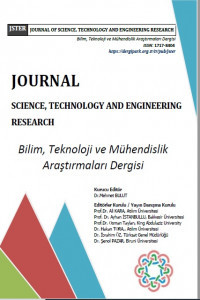A Review of State-of-the-Art Techniques for Power Flow Analysis
Power Flow, Newton-Raphson, Gaus-Siedel, Fast Decoupled
A Review of State-of-the-Art Techniques for Power Flow Analysis
Power Flow, Newton-Raphson, Gaus-Siedel, Fast Decoupled,
___
- [1] M. Z. Islam et al., “Optimal Power Flow using a Novel Harris Hawk Optimization Algorithm to Minimize Fuel Cost and Power loss,” 2019 IEEE Conf. Sustain. Util. Dev. Eng. Technol. CSUDET 2019, no. November, pp. 246–250, 2019, doi: 10.1109/CSUDET47057.2019.9214591.
- [2] V. Veerasamy et al., “A novel RK4-Hopfield Neural Network for Power Flow Analysis of power system,” Appl. Soft Comput. J., vol. 93, p. 106346, 2020, doi: 10.1016/j.asoc.2020.106346.
- [3] S. B. Efe and M. Cebecİ, “Power flow analysis by Artificial Neural Network,” vol. 2, no. 6, pp. 204–208, 2013, doi: 10.11648/j.ijepe.20130206.11.
- [4] V. Veerasamy, R. Ramachandran, M. Thirumeni, and B. Madasamy, “Load flow analysis using generalised Hopfield neural network,” 2018, doi: 10.1049/iet-gtd.2017.1211.
- [5] Z. Li and J. Yu, “Approximate Linear Power Flow Using Logarithmic Transform of Voltage Magnitudes With Reactive Power and Transmission Loss Consideration,” vol. 33, no. 4, pp. 4593–4603, 2018.
- [6] B. G. Risi, F. Riganti-Fulginei, and A. Laudani, “Modern Techniques for the Optimal Power Flow Problem: State of the Art,” Energies, vol. 15, no. 17, 2022, doi: 10.3390/en15176387.
- [7] N. H. Van Der Blij et al., “Improved Power Flow Methods for DC Grids,” IEEE Int. Symp. Ind. Electron., vol. 2020-June, no. 734796, pp. 1135–1140, 2020, doi: 10.1109/ISIE45063.2020.9152570.
- [8] S. I. Evangeline, “Particle Swarm Optimization Algorithm for Optimal Power Flow Incorporating Wind Farms,” 2019 IEEE Int. Conf. Intell. Tech. Control. Optim. Signal Process., pp. 1–4, 2019, doi: 10.1109/INCOS45849.2019.8951385.
- [9] A. Khan, H. Hizam, N. I. bin A. Wahab, and M. L. Othman, “Optimal power flow using hybrid firefly and particle swarm optimization algorithm,” PLoS One, vol. 15, no. 8 August, pp. 1–21, 2020, doi: 10.1371/journal.pone.0235668.
- [10] W. A. Alsulami, “Fast and Accurate Load Flow Solution for On-line Applications Using ANN,” vol. I, no. June, 2017.
- [11] V. Basetti, S. S. Rangarajan, C. K. Shiva, S. Verma, R. E. Collins, and T. Senjyu, “A quasi-oppositional heap-based optimization technique for power flow analysis by considering large scale photovoltaic generator,” Energies, vol. 14, no. 17, 2021, doi: 10.3390/en14175382.
- [12] M. Tostado-véliz, S. Kamel, T. Alquthami, and S. Member, “A three-stage algorithm based on a Semi- Implicit approach for solving the Power-Flow in realistic large-scale ill-conditioned systems,” 2020, doi: 10.1109/ACCESS.2020.2975058.
- [13] M. Tostado-véliz, H. M. Hasanien, S. Member, and R. A. Turky, “Mann-Iteration Process for Power Flow Calculation of Large-Scale Ill-Conditioned Systems : Theoretical Analysis and Numerical Results,” vol. XX, pp. 1–12, 2021, doi: 10.1109/ACCESS.2021.3114969.
- [14] S. Abhyankar and A. J. Flueck, “Fast Power Flow Analysis using a Hybrid Current-Power Balance Formulation in Rectangular Coordinates,” no. 1.
- [15] F. Mumtaz, M. H. Syed, M. Al Hosani, and H. H. Zeineldin, “A Simple and Accurate Approach to Solve the Power Flow for Balanced Islanded Microgrids,” pp. 1–5.
- [16] L. P. System, Z. Liu, Y. Song, Y. Chen, S. Huang, and M. Wang, “Batched Fast Decoupled Load Flow for,” 2018 Int. Conf. Power Syst. Technol., no. 201804270000856, pp. 1775–1780, 2018.
- [17] R. Gono and Z. Leonowicz, “A New Approach Newton-Raphson Load Flow Analysis in Power System Networks with STATCOM,” no. August, 2020, doi: 10.1007/978-3-030-14907-9.
- Başlangıç: 2020
- Yayıncı: Mehmet BULUT
Kompozit Levhaların Tamirinde Yama Özelliklerinin Çekme Gerilme Davranışlarına Etkisi
Abdullah ŞİŞMAN, Mehmet RAMAZANOĞLU
Soğuk İşlemle (CW) İşlenen AA 6061 T6 Alüminyum alaşımının Mekanik Özelliklerinin Gelişimi
Yumuşak zeminde tünel kazısının 3 boyutlu simülasyonu
Studied the Impact of the Foundation on the Underground Cavity Using the Finite Element Method
Hosni Abderrahmane TALEB, Ismahene GUEMIDI
Betül ŞAHİN, Başak ÜNVER KOLUMAN, Mücahit SEÇME, Yavuz DODURGA, Gülçin ABBAN METE, Mustafa KÖSE, Mahmed Sari NJJAR, Ahmet KOLUMAN
A Review of State-of-the-Art Techniques for Power Flow Analysis
Alıyu SABO, Kamaluddeen IBRAHIM KANYA, Nazıru SHU'AIBU, Chıgozıe ONYEMA, Ahmed ALIYU, Hadıza TANKO, Sama'ıla KWASAU
